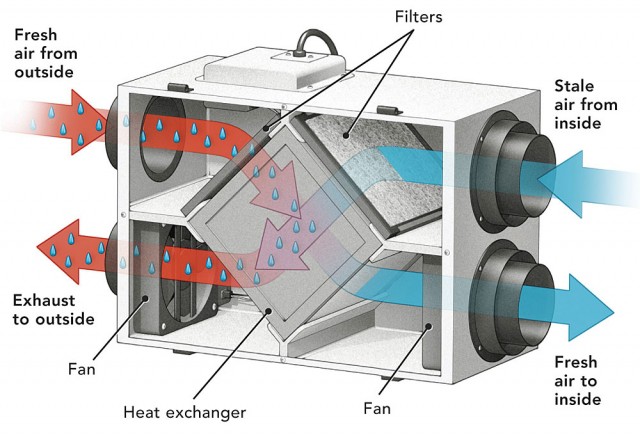Checking out the Perks of Heat Recovery Ventilation for Power Efficiency in Residences
Heat Recovery Ventilation (HRV) systems offer homeowners a practical technique to boosting energy efficiency. By recovering heat from outgoing air, these systems can significantly minimize heating and cooling expenses. In addition, they offer a constant supply of fresh air, boosting indoor air quality and comfort degrees. As home owners consider lasting alternatives, recognizing the subtleties of HRV systems becomes progressively essential. What variables should one assess prior to making such an investment?
Comprehending Heat Recovery Ventilation Solutions

Exactly How HRV Improves Indoor Air High Quality

Power Cost Savings: The Financial Advantages of HRV
Taking full advantage of power performance, heat recovery ventilation (HRV) systems use substantial financial benefits for house owners. By recovering and recycling warmth from exhaust air, HRVs significantly reduce cooling and heating prices. This innovation can cause energy financial savings of approximately 30%, depending upon climate and usage patterns. Homeowners commonly see decreased utility bills soon after setup, making HRVs a monetarily wise investment with time. In addition, several regions offer rewards or refunds for energy-efficient upgrades, further boosting the economic allure. As power costs remain to climb, the cost-effectiveness of HRVs ends up being increasingly clear. In general, the unification of HRV systems not only promotes power effectiveness but additionally adds to long-term financial savings for families.
The Environmental Influence of Heat Recovery Ventilation
A considerable environmental benefit of heat recovery ventilation (HRV) systems hinges on their capacity to lower overall energy intake. By recovering warm from exhaust air and transferring it to inbound find out fresh air, HRV systems reduce the demand for energy-intensive heating and cooling down methods. This decrease in power demand contributes to lower greenhouse gas exhausts, as less fossil fuel is required to maintain comfy interior temperatures. Additionally, HRV systems boost indoor air quality by effectively trading stagnant air with fresh outdoor air, decreasing reliance on mechanical air conditioning systems that can hurt the atmosphere. Overall, the implementation of HRV systems sustains lasting living techniques and lines up with international initiatives to deal with environment change by promoting energy efficiency in property setups.
Selecting the Right HRV System for Your Home
Exactly how can home owners guarantee they choose the appropriate heat recovery ventilation (HRV) system for their requirements? They should analyze their home's size and format, as these elements influence Check This Out air movement requirements. Next off, assessing the system's effectiveness scores is crucial, as greater rankings show better performance and energy cost savings. House owners must also consider setup and maintenance expenses, contrasting different brand names and models for worth. Additionally, it's crucial to review sound levels, as some systems run more quietly than others. Consulting with a/c professionals can supply tailored recommendations based upon certain home problems. Ultimately, checking out individual evaluations and service warranties can aid in making a notified choice, making certain that the selected HRV system successfully enhances interior air top quality and power effectiveness.
Often Asked Concerns

Just how Frequently Should I Clean or Keep My HRV System?
The regularity of cleansing or preserving a heat healing ventilation (HRV) system typically relies on use and environmental factors. Usually, it is a good idea to carry out upkeep every six months to guarantee peak performance and air high quality.

Can HRV Solutions Help Decrease Moisture Levels Inside Your Home?
HRV systems can successfully reduce interior moisture degrees by why not check here trading stagnant, humid air with fresh, drier air from outdoors. HRV Heat Recovery Ventilation. This process helps preserve a well balanced interior setting, improving convenience and stopping moisture-related issues
What Is the Life expectancy of a Typical HRV System?
The lifespan of a normal heat recovery ventilation (HRV) system varies, generally lasting in between 10 to 15 years. Normal upkeep can extend its effectiveness and operational life, guaranteeing peak efficiency throughout its use period.
Exist Any Type Of Noise Problems With HRV Systems?
Sound issues with HRV systems can occur, specifically from follower operation. Lots of modern-day units are made to lessen audio levels, guaranteeing they run quietly while keeping effectiveness, which resolves potential disturbances in living atmospheres.
Can I Mount an HRV System Myself, or Do I Need an Expert?
The specific contemplated whether to set up the heat recovery ventilation (HRV) system directly or work with a specialist. Usually, while do it yourself installment is feasible, knowledge guarantees correct functionality and conformity with regional building codes, improving system effectiveness.